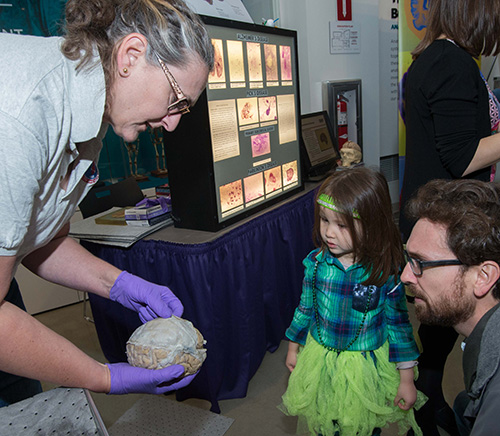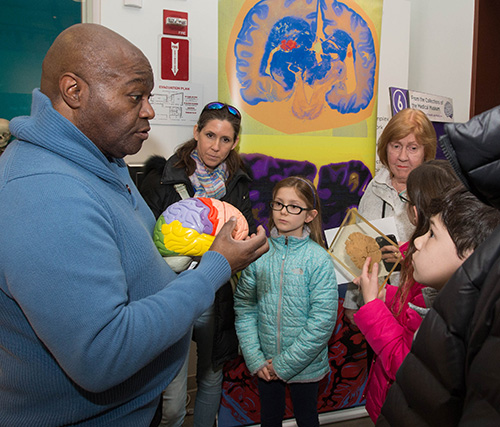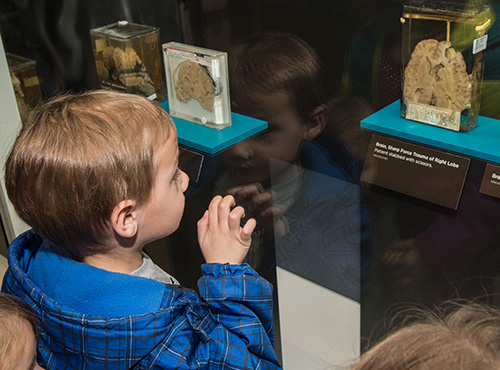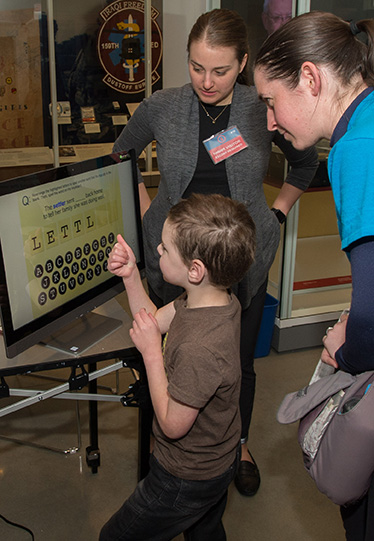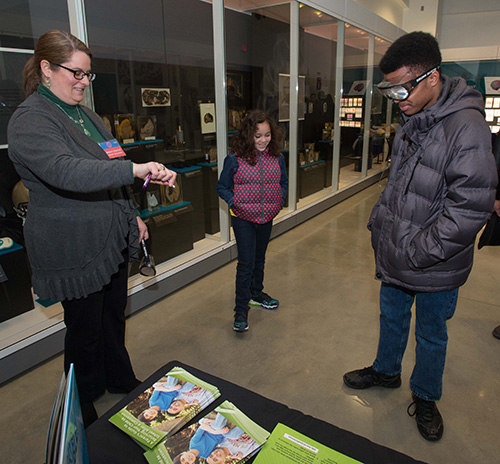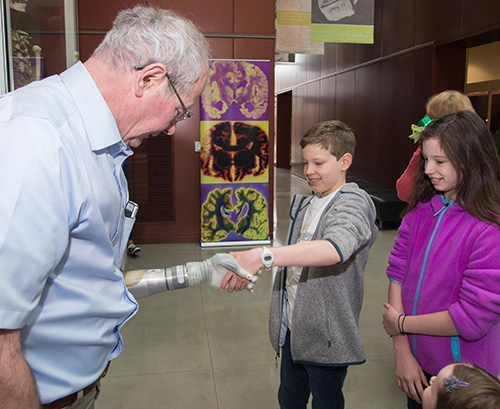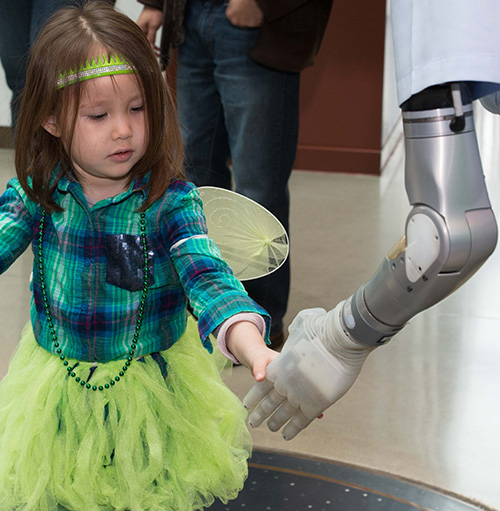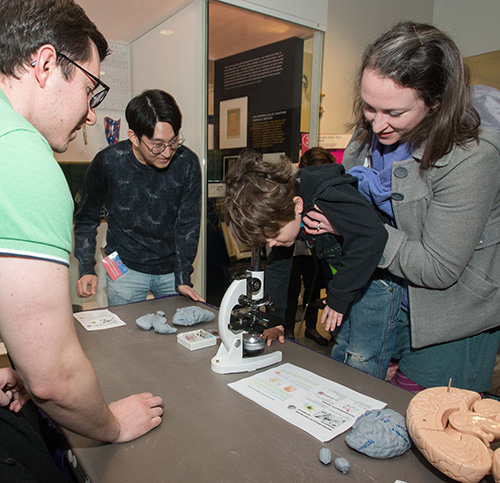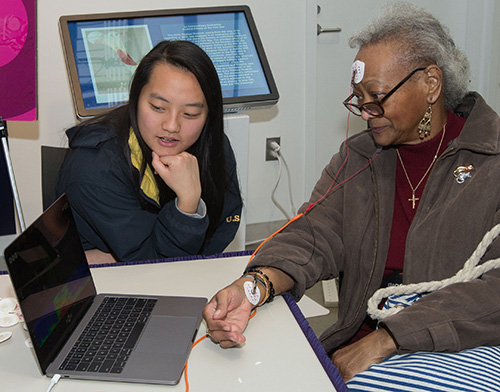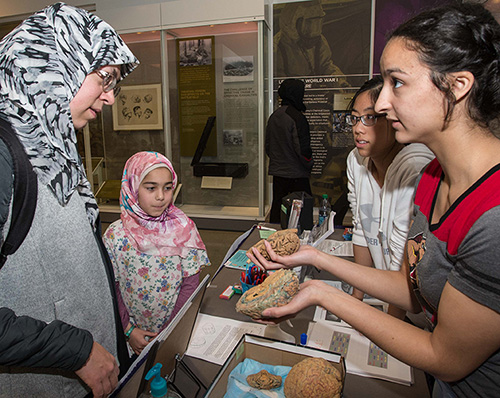Medical Museum's Brain Awareness Day Open House Provided Neuroscience Lessons for Learners of All Ages
By Lauren Bigge
NMHM Public Affairs Coordinator
People of all ages came to the National Museum of Health and Medicine (NMHM) on Saturday, March 17 to learn about neuroscience, the brain-body connection, and protecting the brain from injury during the museum's first Brain Awareness Day open house. March is recognized as Traumatic Brain Injury Awareness Month by the Department of Defense (DoD) each year; NMHM is a DoD museum and a division of the Defense Health Agency.
Brain Awareness Day attendees heard about brain anatomy and traumatic brain injury from NMHM's Archibald Fobbs, Neuroanatomical Collections manager, at his "Brain Collector" station, as Human Developmental Anatomy Collections manager Elizabeth Lockett assisted individuals in holding a real human brain from the museum's collection. NMHM is home to one of the world's most comprehensive neuroanatomical collections and features an extensive exhibit on traumatic brain injuries. The exhibit showcases actual human brain specimens that demonstrate a variety of brain injuries including hemorrhages, blunt force trauma, sharp force trauma, and concussion.
At the "Brain Pain" station, personnel from the Speech Pathology Center at Walter Reed National Military Medical Center's National Intrepid Center of Excellence gave visitors a chance to experience the challenges that may come with communicating after a brain injury. "We're trying to convey the message that after brain injury, you may have difficulty with communication and thinking skills, so we provide an activity that provides an analogy to that challenge," said Shannon Auxier, speech-language pathologist.
Visitors to the DoD's Defense and Veterans Brain Injury Center (DVBIC) station had the opportunity to ask questions about brain injuries, especially concussions in the context of accidents like a fall or bicycling mishap. DVBIC is the traumatic brain injury (TBI) center of excellence for the Defense Health Agency, promoting state-of-the-science care from point-of-injury to reintegration for service members, veterans, and their families to prevent and mitigate consequences of mild to severe TBI. At 22 sites, DVBIC treats, supports, trains, and monitors service members, veterans, family members and providers who have been, or care for those who are, affected by traumatic brain injury.
Families got a chance to meet and shake hands with a Vietnam War veteran's bionic arm at "The DEKA Arm: A Mind-controlled Prosthetic" station. "It's always a learning process to figure out which grip is best for which job," said Fred Downs, retired national director of the U.S. Department of Veterans Affairs (VA) Prosthetic and Sensory Aids Service, describing the DEKA Arm System prosthetic device he wears. "It's very intuitive." The DEKA Arm System hand can perform different, pre-programmed grips, exerting various strengths to pick up and manipulate objects. Downs demonstrated the "power" grip, which allows him to hold something heavy; the "fine pinch open" and "fine pinch closed" grips that allow him to hold a penny or other very small object; and the "lateral pinch," which works for holding an item like a key. Downs, who represented the Paralyzed Veterans of America on Brain Awareness Day, repeatedly told attendees: "You shook hands with a robot!" The DEKA Arm System was developed by DEKA Research & Development with funding from the Defense Advanced Research Projects Agency (DARPA). NMHM features a DEKA Arm System on display in an exhibit on innovations in military medicine.
Representatives from the DC Metro Area Chapter of the Society for Neuroscience showed visitors the similarities and differences between a human brain and brains of other species. "We're teaching the kids the fundamentals of the brain," said Nick Jury, chapter president. Participants looked at a brain specimen under a microscope, and saw what their brain waves looked like on a computer screen while electroencephalography (EEG) sensors were attached to their heads.
At the "Growing Up Is Hard to Do!" station, personnel from the University of Maryland-College Park, Infant and Child Studies Consortium showed off plastinated specimens and provided information such as seven facts about the developing brain. "We brought two brains; one is healthy and one is affected by a stroke," said Shirley Duong, a University of Maryland lab manager. "We conduct a series of studies on the brains of kids with developmental delays, autism, ADHD," she added, noting that they study infants and children ranging in age from 3 months to 18 years old.
"The Brain Awareness Day program provided an opportunity to reach community audiences of all ages," said Andrea Schierkolk, NMHM public programs manager. "For the past nineteen years, our Brain Awareness Week programs have focused on introducing middle school students to military medicine and opportunities in neurosciences. This Saturday program provided a dynamic forum for brain scientists to interact with the general public and to share with the community the unique neuroscience-related research assets of the Medical Museum."
Brain Awareness Week programming at NMHM is one of the museum's central efforts to support Department of Defense STEM (science, technology, engineering and math) workforce development priorities. NMHM is a division of the Defense Health Agency Research and Development Directorate.
